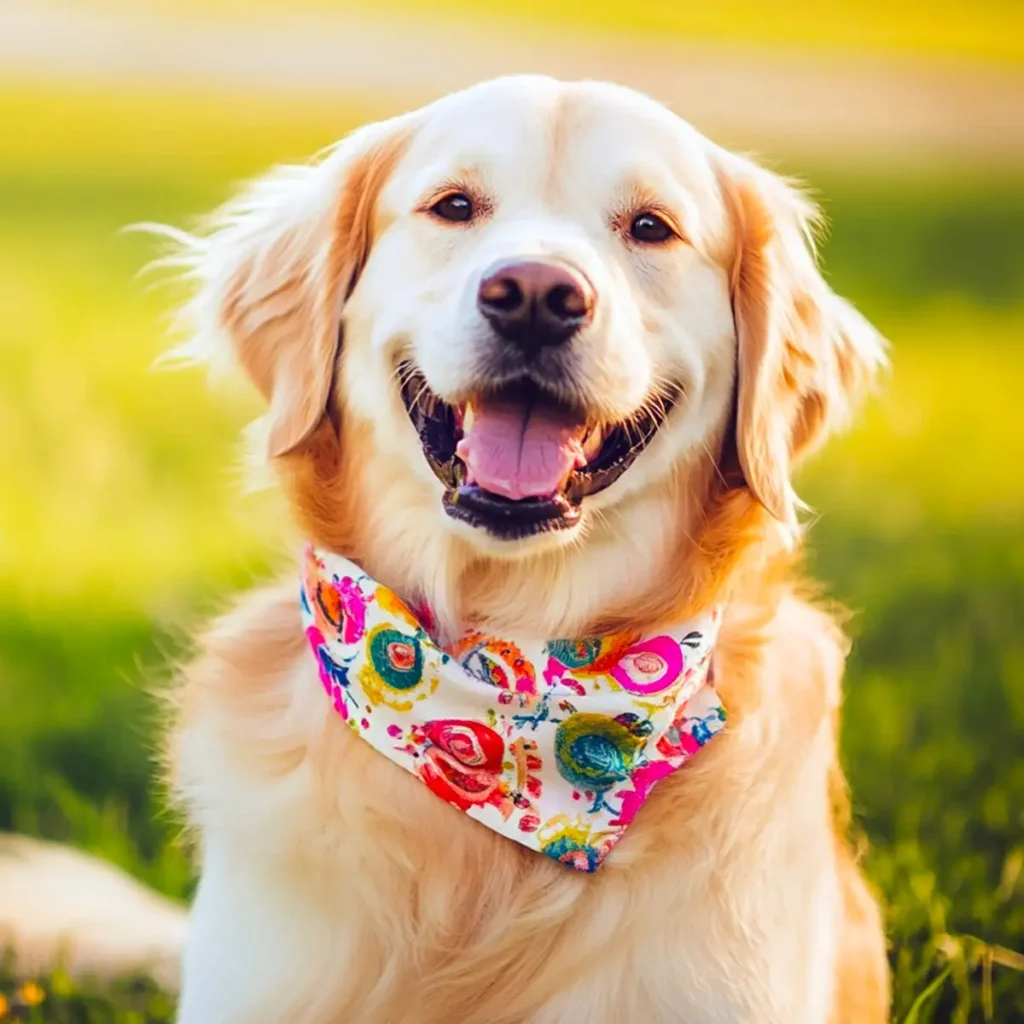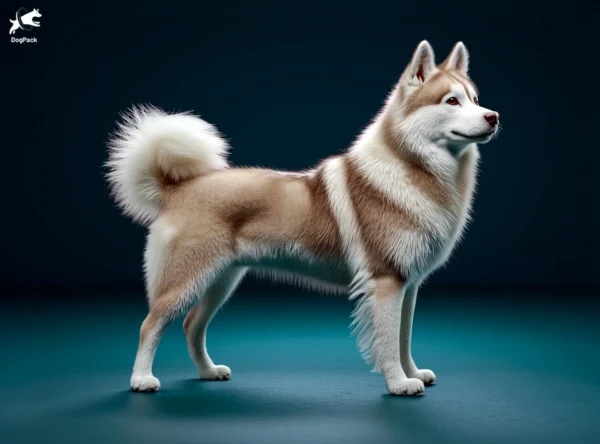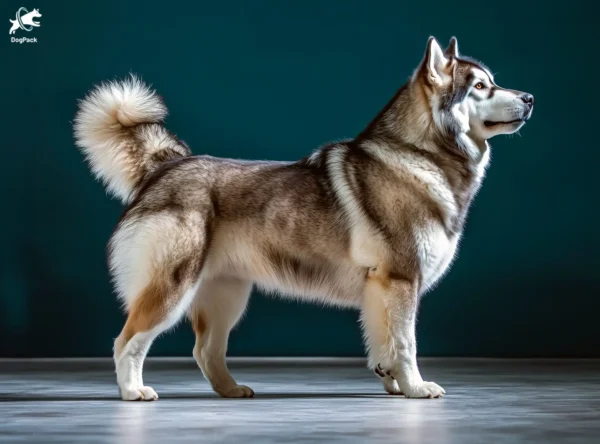Greenland Dog Breed Info & Overview
Stare into the eyes of a Greenland Dog and you might feel like you’re looking back in time. This muscular spitz‑type sled dog was brought to Greenland centuries ago and still carries the wild spirit of the Arctic. With a thick double coat, boundless energy and a stubborn streak, it’s a breed for those who thrive outdoors. Expect loyalty, tenacity and a howling serenade instead of a bark.
Characteristics
Pictures
Breed History
The Greenland Dog has an origin story as vast as the ice sheets it once crossed. Archaeological evidence suggests its ancestors arrived in the Americas thousands of years ago with Paleo‑Eskimo people. By the time the Thule people brought their sled dogs from Siberia around 1,000 years ago, this hardy breed was already valued for hauling sleds and hunting.
European explorers later discovered the breed’s strength. A female “Esquimaux dog” was exhibited at one of Britain’s earliest dog shows in 1875, and the Kennel Club recognized these dogs in 1880. Famous polar adventurers like Roald Amundsen trusted teams of Greenland Dogs to pull supplies on their journeys to the South Pole.
Isolation preserved their genetics. In Greenland’s north and east, it’s illegal to import other dogs, and every sled dog must be microchipped to safeguard purity. Genetic studies show the breed remained isolated since its arrival, tracing ancestry back to ancient Arctic wolves. These measures help protect a working dog that’s both a national treasure and one of the world’s oldest breeds.
Temperament, Personality
Hardy and stoic, the Greenland Dog acts more like an old friend from the wilderness than a lap dog. It’s affectionate toward its pack but doesn’t attach itself to one person. Instead of barking, it communicates with howls and joyful screams, which new owners may mistake for complaints.
Independence runs deep in this breed. They were bred to work with little human direction, so they need an experienced, authoritative handler. Without clear leadership, they’ll happily take charge of the household. Their strong prey drive and territorial nature make early socialization essential to prevent quarrels with other dogs.
Despite their stubborn streak, Greenland Dogs bond deeply with other pack members and revel in teamwork. Give them a job — pulling a sled, carrying a backpack or playing canine sports — and you’ll see their eyes sparkle. Just be prepared for a lot of vocal “singing” when they’re excited.
Physical Characteristics
Imagine a wolf dressed for the Arctic and you’ll get close to the Greenland Dog’s look. This breed is powerfully built with a broad, wedge‑shaped head and slightly tilted eyes. Small, triangular ears covered in thick fur protect against frostbite, and a bushy tail curls over its back to warm its nose during blizzards.
The coat is a marvel of engineering: a dense wool‑like undercoat and a longer, coarse outer coat that repels water. Hair on the head and legs is shorter, while the body and tail sport longer fur. Coloration ranges from black to fawn; blue eyes and merle or albino markings are disqualifications.
Males stand about 60 cm (23.6 in) at the shoulder, with females slightly smaller. Their muscular legs and big, rounded feet equip them for deep snow. A triangular marking called the “úlo” often appears on the shoulders — a nod to the knife used by Greenlandic women
Health Issues
Because they evolved in harsh conditions, Greenland Dogs are generally robust. However, like other large breeds, they can suffer from musculoskeletal issues such as hip and elbow dysplasia. Lens luxation and other eye conditions are minor concerns in the breed.
Occasional health problems include ear infections, gastric torsion (bloat) and lens luxation. Their deep chest means owners should watch for signs of bloat, especially after vigorous exercise. Working dogs may also experience injuries from pulling sleds or carrying heavy loads.
Regular veterinary check‑ups and preventative screenings help detect issues early. Routine X‑rays and physical examinations are recommended. Because the breed is so hardy, a healthy Greenland Dog can live 10–14 years — not bad for a dog that thrives in such extreme conditions.
Grooming Needs
Despite their thick coats, Greenland Dogs aren’t as high‑maintenance as they look. Most of the year, weekly brushing keeps their fur tidy. During the annual “coat blow,” when they shed their undercoat all at once, daily brushing helps prevent tumbleweeds of hair and spares your furniture.
Bathing is rarely needed — these dogs are surprisingly clean and should only be bathed every few months. What needs regular attention are ears, nails and teeth. Their thick ear fur traps debris and moisture, so check and clean ears weekly to avoid infections. Trim nails to prevent discomfort and brush teeth to ward off dental disease.
During grooming, take a moment to admire the “úlo” shoulder marking or count the snowshoe‑like toe pads. A calm grooming session can double as bonding time, which this independent dog secretly enjoys.
Exercise Requirements
If there were an Olympic medal for endurance, the Greenland Dog would take gold. Bred to haul sleds across ice for miles, these dogs need extensive daily exercise — two hours is a minimum. Long runs, hiking with a loaded backpack or skijoring are ideal; leisurely strolls around the block simply won’t cut it.
Their mental batteries are just as powerful as their physical ones. Without a job, they become bored and may start redecorating your home through creative digging or howling. Keep them busy with canine sports like agility, tracking or weight pulling. They also enjoy pulling carts or children’s sleds in winter, channeling centuries of genetic drive.
Because of their stamina, they outlast many human running partners. Don’t be surprised if your Greenland Dog looks offended when you head back home after an hour. To truly satisfy this breed, plan adventures that challenge both body and brain.
Training Tips
Training a Greenland Dog is like convincing a seasoned explorer to follow a map — it takes patience and respect. These dogs are intelligent and often eager to work, but they were bred to think independently. Establish yourself as pack leader early, using firm, consistent boundaries and lots of positive reinforcement.
Early socialization prevents territorial behavior toward other dogs. Introduce puppies to new sights, sounds and situations, and reward calm behavior. Greenland Dogs respond poorly to harsh training; they’ll shut down or become stubborn. Instead, make training sessions short, fun and purposeful — think pulling a cart or learning to find hidden treats under snow piles.
Enlist the help of an experienced sled‑dog trainer if possible. Working in a team harness with other dogs will teach your Greenland Dog to follow commands while satisfying its instinct to work. Remember that even well‑trained dogs will howl when excited — consider it part of their charm.
Nutrition, Diet
Feeding a Greenland Dog isn’t as simple as pouring kibble into a bowl. These high‑energy sled dogs need a diet tailored to their workload. In winter, when they’re pulling sleds or hiking through snow, they require a higher protein and fat content. In the off‑season, reduce calories to prevent weight gain.
Measure portions carefully, as treats should make up less than 10 % of daily calories. A typical adult may eat 4 cups of high‑quality working‑dog formula per day, but adjust based on activity level and body condition. Because these dogs are prone to bloat, divide meals into two smaller feedings and avoid vigorous exercise immediately after eating.
Fresh water is essential, especially during intense activity. Some owners add fish oil or joint supplements to support their musculoskeletal health. Consult a veterinarian familiar with sled dogs to design a nutrition plan that keeps your dog strong through winter expeditions and summer hikes.
Adoption, Breeders
Finding a Greenland Dog outside of the Arctic can feel like a treasure hunt. In Greenland, importation of other breeds is restricted to preserve genetics, so breeding programs are tightly controlled. If you’re serious about this rare breed, start by contacting recognized clubs such as the Greenland Dog Club of Great Britain or reading the FCI breed standard for guidance.
Because they are rare, some prospective owners consider adopting a similar working dog breed instead. Rescue organizations occasionally rehome retired sled dogs; ensure you’re ready to meet their needs before adopting. Visit breeders in person to evaluate temperament and living conditions, and ask about health screenings for hips, elbows and eyes.
Beware of “fad” breeders selling cross‑breeds as pure Greenland Dogs. A reputable breeder will provide documentation and may ask about your experience with large, independent dogs. This is not a breed for impulse adoption — thorough research ensures you and your future sled dog start off on the right paw.
Family Pet?
Is the Greenland Dog a good family pet? It depends on your family’s lifestyle. In the right hands, these dogs can be gentle and affectionate companions. I once watched a Greenland Dog patiently pull my friend’s kids around a frozen lake, tails wagging all the way. However, they need an owner who can set firm rules and provide endless exercise.
Because they are large and boisterous, they may unintentionally knock over small children during play. Their independence means they don’t crave constant human attention, which can disappoint families expecting a cuddly lap dog. With proper socialization, they can coexist peacefully with other dogs, but their prey drive makes them less reliable around cats or smaller pets.
Ultimately, a Greenland Dog fits best with outdoorsy families who understand the demands of large dog breeds and are prepared to spend hours each day exercising a sled dog. Apartment dwellers or first‑time owners should consider more relaxed companions.
Right For You?
Ask yourself a few questions before bringing home a Greenland Dog: Do you enjoy sub‑zero hikes? Can you commit to at least two hours of strenuous exercise daily? Are you confident handling a dog that sometimes sings at the moon instead of barking?
This breed thrives in cold climates and struggles in heat. They need room to run and work, making them a poor choice for apartments or warm regions. Owners must embrace the challenge of training an independent dog and accept that obedience takes consistency and patience.
If you answered yes to those questions, the Greenland Dog could become your ultimate adventure partner. If not, exploring other rare dog breeds or working breeds might lead you to a companion better suited to your lifestyle.
Conclusion
Owning a Greenland Dog is both a privilege and a commitment. This ancient sled dog offers unwavering loyalty, immense strength and a voice that will serenade you under the northern lights. Its history stretches back millennia, and modern breeders work hard to preserve those qualities. With proper training, nutrition and plenty of exercise, it can be a devoted companion for the right owner.
However, this breed isn’t for everyone. Its high energy, independent mind and need for cold climates make it challenging for casual pet parents. Before you dive in, weigh the pros and cons, talk to experienced owners and maybe visit a sled‑dog event. If you take the plunge, share your own stories with fellow enthusiasts — the Greenland Dog community is small but passionate.
FAQs
-
Why doesn’t the Greenland Dog bark?
The Greenland Dog communicates through howls and screams rather than traditional barking. This trait evolved from working in packs across vast distances, where howling carried further. Expect melodic serenades that can surprise neighbors unfamiliar with this ancient sled dog.
-
Can a Greenland Dog live in a warm climate?
Greenland Dogs are built for arctic conditions. Their thick double coats and preference for cold make hot climates uncomfortable. If you live in a warm region, ensure plenty of shade, air conditioning and avoid midday activity. In general, they thrive best in cooler environments.
-
How much food does a Greenland Dog eat during winter?
Working Greenland Dogs may consume around 4 cups of high‑quality, high‑protein food per day during winter, adjusting portions based on workload. More protein and fat are needed when pulling sleds. Consult a vet experienced with sled dogs to tailor portions to your dog’s activity level.
-
Are Greenland Dogs good swimmers?
Despite their love of snow, many Greenland Dogs enjoy water in warm months. Their dense coat provides buoyancy, but always supervise around deep water. Swimming can be a great way to exercise them without stressing joints, especially during off‑season training.
-
What does “Kalaallit Qimmiat” mean?
“Kalaallit Qimmiat” is the Greenlandic name for the Greenland Dog. It translates roughly to “dog of the Kalaallit people,” honoring the indigenous communities who developed and relied on this breed for transportation, hunting and companionship in one of the world’s harshest environments.
Breed Ratings
Smart and independent, this breed learns quickly but prefers to think for itself, so consistent leadership is essential.
Enjoys boisterous play with its pack and outdoor games; however, roughhousing can overwhelm small children.
One of the most energetic breeds; needs hours of vigorous activity daily to stay content and healthy.
Heavy seasonal shedding during the coat blow; weekly grooming manages fur the rest of the year.
Strong hunting instinct from centuries of seal and polar bear hunting; small pets may trigger chasing.
Thick coat requires regular brushing and extra care during shedding season; otherwise relatively low‑maintenance.
Intelligent but stubborn; responds best to firm, positive training and early socialization.
Pack‑oriented and can become distressed when left alone; prefers the company of other dogs or people.
Rarely barks but loves to howl and “sing” — a charming trait for some, noisy for others.
Not a drooly breed; mouths stay relatively dry even when working hard.
Bonds strongly with pack mates but may be territorial with unfamiliar dogs; socialization is key.
Generally hardy; watch for musculoskeletal issues and occasional bloat or eye conditions.













